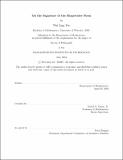| dc.contributor.advisor | David A. Vogan, Jr. | en_US |
| dc.contributor.author | Yee, Wai Ling, 1977- | en_US |
| dc.contributor.other | Massachusetts Institute of Technology. Dept. of Mathematics. | en_US |
| dc.date.accessioned | 2005-05-17T14:43:54Z | |
| dc.date.available | 2005-05-17T14:43:54Z | |
| dc.date.copyright | 2004 | en_US |
| dc.date.issued | 2004 | en_US |
| dc.identifier.uri | http://hdl.handle.net/1721.1/16630 | |
| dc.description | Thesis (Ph. D.)--Massachusetts Institute of Technology, Dept. of Mathematics, 2004. | en_US |
| dc.description | Includes bibliographical references (p. 79-80). | en_US |
| dc.description | This electronic version was submitted by the student author. The certified thesis is available in the Institute Archives and Special Collections. | en_US |
| dc.description.abstract | Classifying the irreducible unitary representations of a real reductive group is equivalent to the algebraic problem of classifying the Harish-Chandra modules admitting a positive definite invariant Hermitian form. Finding a formula for the signature of the Shapovalov form is a related problem which may be a necessary first step in such a classification. A Verma module may admit an invariant Hermitian form, which is unique up to multiplication by a real scalar when it exists. Suitably normalized, it is known as the Shapovalov form. The collection of highest weights decomposes under the affine Weyl group action into alcoves. The signature of the Shapovalov form for an irreducible Verma module depends only on the alcove in which the highest weight lies. We develop a formula for this signature, depending on the combinatorial structure of the affine Weyl group. | en_US |
| dc.description.statementofresponsibility | by Wai Ling Yee. | en_US |
| dc.format.extent | 80 p. | en_US |
| dc.format.extent | 424571 bytes | |
| dc.format.extent | 418741 bytes | |
| dc.format.mimetype | application/pdf | |
| dc.format.mimetype | application/pdf | |
| dc.language.iso | eng | en_US |
| dc.publisher | Massachusetts Institute of Technology | en_US |
| dc.rights | M.I.T. theses are protected by copyright. They may be viewed from this source for any purpose, but reproduction or distribution in any format is prohibited without written permission. See provided URL for inquiries about permission. | en_US |
| dc.rights.uri | http://dspace.mit.edu/handle/1721.1/7582 | |
| dc.subject | Mathematics. | en_US |
| dc.title | On the signature of the Shapovalov form | en_US |
| dc.type | Thesis | en_US |
| dc.description.degree | Ph.D. | en_US |
| dc.contributor.department | Massachusetts Institute of Technology. Department of Mathematics | |
| dc.identifier.oclc | 56019282 | en_US |
